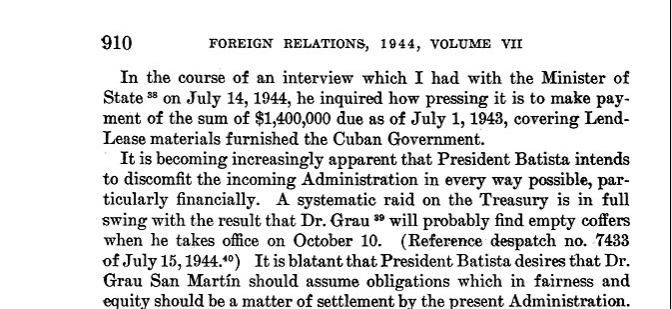
The luxury Hotel Nacional de Cuba, in Havana is a sight. It harks to the days when Marlon Brando and Ernest Hemingway would cross paths on the cobbled island streets, and the who's who of the world descended on the island's pristine beaches and diamonds glistened under a starry Cuban sky.
It was a time of plenty, and a time of greed; and at the epicenter of the swirling maelstrom of guns and gowns, wheels and deals, there stood the Nacional: A bastion of excess that would see the best and worst of a pre-revolution Cuba.
In September 1933, Meyer Lansky, the "mob's accountant", travelled to Cuba to meet with the Cuban Armed Forces Chief, Fulgencio Batista. It was a business deal.
Working on behalf of his associate, the notorious American mobster Salvatore 'Lucky' Luciano, Lansky proposed that all the island's gaming rights be given to the US Mafia. Of course, the Nacional and its casino was the jewel in the proverbial crown.
Armed with $3 million in cash, Lansky had no problem getting Batista to agree to his terms. Batista would henceforth be referred to by the mob as "our man in Cuba".
The partnership was cemented when Batista became president in 1940 and later, after a coup in 1952, dictator of Cuba. The mob had found a new home, far from the prying eyes American authorities, not least of which was the IRS, that had brought down Al Capone.
As Luciano recalls in his book, The Last Testament of Lucky Luciano: "Cuba was our first attempt in the Caribbean islands".
But Luciano wanted Cuba for more than just its ritzy hotels, casinos, and glittering cast of blinkered stars. Luciano also realised that Cuba's busy air and sea links with the American mainland meant that it was an ideal transit points for drugs like cocaine and primarily, heroin.
In 1944 Ramón Grau won the popular vote in the Cuban presidential election, defeating Carlos Saladrigas Zayas, Batista's handpicked successor.
All was well for a while but in a July 17, 1944 dispatch to the US Secretary of State, US Ambassador Spruille Braden stated: It is becoming increasingly apparent that President Batista intends to discomfit the incoming Administration in every way possible, particularly financially. A systematic raid on the Treasury is in full swing with the result that Dr Grau will probably find empty coffers when he takes office on October 10. It is blatant that President Batista desires that Dr Grau San Matin should assume obligations which in fairness and equity should be a matter of settlement by the present Administration.
The Mob had already decided that Grau was certainly not "their man in Havana" and soon began a campaign to make his presidency as untenable as possible.

But something bigger was afoot. On December 20, 1946, leaders of the Cosa Nostra and the US Mafia descended on the Nacional for what would later be called the Havana Conference, organised by Lucky Luciano.
It was Luciano's intention to use the conference to once-and-for-all be accepted as the "boss of bosses" or "first among equals" of the National Crime Syndicate. Luciano was keenly aware that since his deportation in 1946, Vito Genovese had been making moves to replace Luciano at the top of the mob pyramid. But Luciano was nothing if not a sure-footed wanderer of the mafia maze.
Backed by Albert 'The Mad Hatter' Anastasia, Luciano quickly succeeded in getting the other families to back him and put paid – at least in the short term – to Genovese's plans.
With that settled, Luciano moved on to the most pressing matter at hand: the narcotics trade. While a few families baulked at the thought of dealing in drugs – they feared it would bring down to much attention from the US authorities – most felt the tug of an easy windfall.
Cosa Nostra was already using Cuba as a hub to transport drugs from South America and South-East Asia into Florida and the US. Luciano, however, had turned his deportation back to Italy into an opportunity to create a heroin line of supply from North Africa, through Italy and into Cuba, and then onwards to ports in New York and New Orleans.
Various crime families would handle their "ports" while Luciano would make sure the drugs got to them. Sold on the routes and the infrastructure – much of which was already in place – the family bosses voted to support Luciano's drug-trade plans.
Notwithstanding the simmering tensions between Luciano and Genovese, the Havana Conference ended pretty much the way Luciano had envisioned it would.
For the next few years Cuba would be the epicenter of the Western drug trade, but a brewing war between the US mob families saw a number of high-ranking players move to the relative safety of Havana, where the casinos rang and the living was good.
All that would change in the blink of an eye. In July 1953, Fidel Castro and Che Guevara launched the Cuban revolution. For a while Havana existed on the periphery of the conflict, but on January 1, 1959, Cuban revolutionaries unseated Batista, and the Western world changed forever.
The Mafia fled Cuba with whatever they could get their hands on, which was not much. The smarter players had already moved their trading hubs to other centres in Central America and the Caribbean. But the swinging days of Havana were effectively over. And like the final nail in the proverbial coffin, in October 1960, Castro officially closed the Nacional, bringing down the curtain on a hedonistic age the likes of which few people had ever seen.
You can still find traces of the mob in Havana, sites where speakeasies once stood; where bejeweled women walked the promenades. Overlooking the memories stands the Nacional, and somewhere in the bowels of the concrete behemoth, you can still hear Frank Sinatra and Nat King Cole, and the garrulous chatter between Lucky Luciano and Lansky as they plotted to rule the world.

















